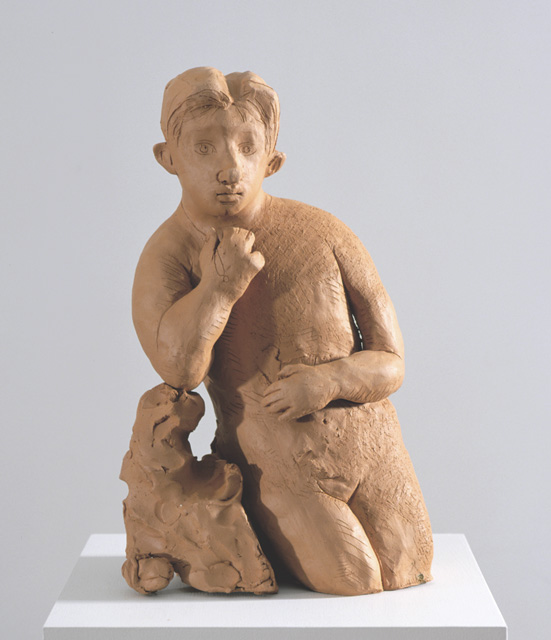


The history of modernism is riddled with jokes: products of the aggressive, anti-art humour of the Dada movement, or the elaborate in-jokes of Pop Art. Post-modern art, too, often has its tongue in its cheek as it stages elaborate pantomimes shot through with ironic echoes of the glory days of modernity. Linda Marrinon's work is funny, but in a funny way. Something of the ironic thread of post-modernism can be detected in her allusions to Matisse in Nude with green bottles (1990), to neoclassical sculpture in Standing figure with clouds (1994) and to the landscape tradition in Birds at Point Lonsdale (1996). But there's more to Marrinon than the cool, sly wink of post-modernism: her art makes the audience laugh out—not something you often hear in an art gallery. Stranger still, Marrinon's humour is not directed against art. Her mixtures of abstraction and figuration, of cartoons and classicism, and of heroes and clowns are not intended to demean art; instead, her art seems to bubble over with pleasure at what art can do.
Marrinon's wit, and her determined exploration of art historical genres (portraiture, landscape, figure painting, still life), reveal an artist preoccupied with art's status in a culture brimming over with visual stimuli. In what ways, she seems to ask, can a painting compete with a holiday snap, an advertisement, a movie or a fashion shoot—much less with other paintings? Will art's values and categories remain intact in the face of contemporary visual culture's disregard for conventions? Asking such questions doesn't make Marrinon defensive or conservative; she is as inclined to mix and match visual styles as any art director. But she does exploit the way in which art encourages viewers to dwell on visual stimuli. Nude with green bottles explores surface decoration, Standing figure with clouds seduces with sinuous contours and Birds at Point Lonsdale is loaded with small traces of the physicality of paint and its application. Marrinon's defence of art rests on her display of its particular pleasures, even as she admits that other forms of pleasure (cartoons, calendars and fashion) are equally appealing.
Marrinon's art appeals strongly to other artists; she may not be a household name but she is definitely a 'painter’s painter'. One reason for this is that she so self-evidently has fun with what she is doing. Another is the ease with which she balances on the boundary between different styles and cultural categories. When Marrinon mixes painting and cartoons, she is not looking for the difference between them; instead, she asks why we need to differentiate between them at all. The works try to operate on the basis of several different conventions simultaneously, so that each component can be read in multiple ways. The figures, for example, are comical—even caricatures—but at the same time they strike heroic poses. They invoke not just cartoons but the allegorical figures of classical painting. The same could be said of the flattened-out space of the paintings; it might be the flat space of the comic book but it is reminiscent of the shallow niches within which allegorical scenes are staged. The contours of the figures are readable in terms of painterly skill and also as the deft line of the cartoonist.
As is the case in her paintings, Marrinon's sculptures play with cultural categories: high culture and mass culture, the gallery and the home, art and decoration, good taste and kitsch. Standing figure with clouds seems to invoke the high aspirations of art; a classical pose and a contemplative figure suggest meditation, romanticism and transcendence. But at the same time, these allusions are undercut by the cartoon-like forms and the domestic scale of the piece. The work hovers on the border between museum artefact and mantelpiece knick-knack. This confusion of categories is typical of a tendency for 1990s artists to reject orthodox classifications in favour of a more liberal and pluralistic approach to culture. It echoes a spirit common to post-modernist practices: the refusal of the 'heroic and original' in favour of the 'ugly and ordinary'. But Marrinon targets more than cultural categories themselves; she also takes on gender categories. Her figures are generally male but are presented in ways that gently mock masculine roles. In Standing figure with clouds, she converts the classical philosopher or romantic poet into a sensitive new age guy. In doing so, she charts the genealogy of a 1990s version of masculinity, but also, quite literally, cuts it down to size; her dreamer is brought back to earth with a humorous thud.
- Chris McAuliffe
Linda Marrinon is represented in Australia by Roslyn Oxley9 Gallery, Sydney.